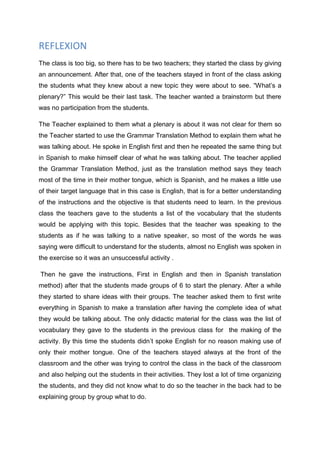
Reflexion 121202193441-phpapp02
- 1. REFLEXION The class is too big, so there has to be two teachers; they started the class by giving an announcement. After that, one of the teachers stayed in front of the class asking the students what they knew about a new topic they were about to see. “What’s a plenary?” This would be their last task. The teacher wanted a brainstorm but there was no participation from the students. The Teacher explained to them what a plenary is about it was not clear for them so the Teacher started to use the Grammar Translation Method to explain them what he was talking about. He spoke in English first and then he repeated the same thing but in Spanish to make himself clear of what he was talking about. The teacher applied the Grammar Translation Method, just as the translation method says they teach most of the time in their mother tongue, which is Spanish, and he makes a little use of their target language that in this case is English, that is for a better understanding of the instructions and the objective is that students need to learn. In the previous class the teachers gave to the students a list of the vocabulary that the students would be applying with this topic. Besides that the teacher was speaking to the students as if he was talking to a native speaker, so most of the words he was saying were difficult to understand for the students, almost no English was spoken in the exercise so it was an unsuccessful activity . Then he gave the instructions, First in English and then in Spanish translation method) after that the students made groups of 6 to start the plenary. After a while they started to share ideas with their groups. The teacher asked them to first write everything in Spanish to make a translation after having the complete idea of what they would be talking about. The only didactic material for the class was the list of vocabulary they gave to the students in the previous class for the making of the activity. By this time the students didn’t spoke English for no reason making use of only their mother tongue. One of the teachers stayed always at the front of the classroom and the other was trying to control the class in the back of the classroom and also helping out the students in their activities. They lost a lot of time organizing the students, and they did not know what to do so the teacher in the back had to be explaining group by group what to do.
- 2. Students were clearly organized in teams of boys and teams of girls, they were allowed to choose the people they wanted to for their teams. Teachers seem to do not have planned to lose so much time on explaining one by one what to do and the instructions were explained in Spanish. Because of being explaining team by team they lost the attention of the rest of the teams and it began a disorder in the classroom. The rest of the class was the same, students having doubts and teachers explaining to them. What students were writing was a conversation between the team members related to an artist, actor, actress or a singer. They needed to make a plenary as if it was a radio show, to write the dialogue between the members and the order of the show. By this time the Grammar Translation was the only methodology for this class. It refers much more to the Mother tongue which was the Spanish and the English or L2 had a little active use. For homework they had to translate all what they were writing during the class. In the adolescent development class we studied a theorist called Margaret Mead who made an investigation about how television and social aspects influence a lot on the identity of an adolescent. She went to Samoa and compared the way they lived and all the social aspects they have in a not very developed country were there is no television and she came to the conclusion that adolescent are very influenced by television and also some sexual aspects. The adolescents that lived in Samoa are not influenced by television so they have a more healthy way of thinking unlike in America that some adolescents have a lot of identity issues. This can relate to the class we observed because they asked them to talk mostly of celebrities that appear on television. This activity may cause controversy in class because at this age students has a lot of favoritism with their artist and idols. We all came to an agreement that the idea was good but the class didn’t went as good as they thought , difficulties like discipline and interest in class, and almost no use of L2 which should be their first priority, the students couldn’t speak L2 and the teachers didn’t make an effort to make them speak English, so no motivation was promoted.